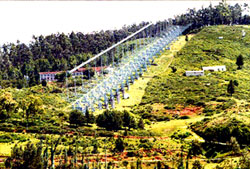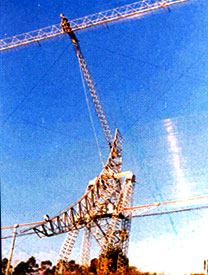Radio
Astronomy Centre |
 The
Radio Astronomy centre (RAC) is part of the National centre of
Radio Astrophysics (NCAR) of the well known Tata Institute of
Fundamental Research (TIFR) which is funded by the Government
of India through the Department of atomic energy . The RAC is
situated near Udhagamandalam in the beautiful surroundings of
the Nilgiri Hills Nd it provides stimulating Environment for the
front-line research in radio astronomy and astrophysics with its
excellent and highly qualified staff and international reputations. The
Radio Astronomy centre (RAC) is part of the National centre of
Radio Astrophysics (NCAR) of the well known Tata Institute of
Fundamental Research (TIFR) which is funded by the Government
of India through the Department of atomic energy . The RAC is
situated near Udhagamandalam in the beautiful surroundings of
the Nilgiri Hills Nd it provides stimulating Environment for the
front-line research in radio astronomy and astrophysics with its
excellent and highly qualified staff and international reputations. |
What
is Radio Astronomy |
Radio
astronomy is the study of the universe through radio waves reaching
us from its many constituents such as the sun, planets, stars,
galaxies, etc. This new branch of science was born 1932 when Karl
Jansky discovered radio noise coming from our Milky Way Galaxy.
Like light waves, radiowaves are also electromagnetic in nature,
but have much longer wave lengths. Different celestial objects
radiate in different, regions of the electromagnetic spectrum-such
as X-ray,optical light, ultra-violet, infra-red rays and radio
waves. Their emission mechanism depends upon the Radio Astronomy
Centre.
The Radio Astronomy centre (RAC) is part of the National Centre
of Radio Astrophysics (NCRA) of the well known Tata Institute
of Fundamental Research (TIFR) which is funded by the Government
of India through the department of atomic Energy. The RAC is situated
near Udhagamandalam in the beautiful surroundings of the Nilgiri
Hills and it provides stimulating environment for the front-line
research in radio astronomy and astrophysics with its excellent
and high qualified staff and international reputations. |
The
Ooty Radio Telescope
|
 The
Ooty radio telescope (ORT), as it is known is cylindrical parabolic
reflecting surface, 530m long and 30m wide,placed on a hill whose
slope of about 11degree in the north-south direction is the same
as the latitude of the RAC. This make if possible to track celestial
object for about 10 hours from their rising in east to their setting
in the west by simply rotating the antenna mechanically along
its long axis. The antenna beam can be steered in the north-south
direction by electronic phasing of the reflector. The reflecting
surface is made up of 1100 thin stainless steel wires, each 530
m long 0.38 mm in diameter. It is supported by 24 parabolic frames
separated by 23m from each other. The
Ooty radio telescope (ORT), as it is known is cylindrical parabolic
reflecting surface, 530m long and 30m wide,placed on a hill whose
slope of about 11degree in the north-south direction is the same
as the latitude of the RAC. This make if possible to track celestial
object for about 10 hours from their rising in east to their setting
in the west by simply rotating the antenna mechanically along
its long axis. The antenna beam can be steered in the north-south
direction by electronic phasing of the reflector. The reflecting
surface is made up of 1100 thin stainless steel wires, each 530
m long 0.38 mm in diameter. It is supported by 24 parabolic frames
separated by 23m from each other. The
telescope operates in a band of maximum bandwidth of 15MHz centered
on a radio frequency of 327 MHz (a wavelength of 0.92 m) the large
size of the telescope make it highly sensitive. As an example,
it is in principle capable of detecting signals from a mere 1
watt radio station located ten million kilo meter away in space.
The
Ooty radio telescope has been designed and fabricated fully indigenously.
The ORT was completed in 1970 and continues to be one of the most
sensitive radio telescopes in the world. Observations made using
this telescope have led to important discoveries and to explain
various phenomena occurring in our Solar system and in other celestial
bodies.
Over
the 30 years, for example, the ORT has produced many important
astronomical results on radio galaxies, quasars, supernovae, pulsars,
the interstellar and interplanetary media act. One of the most
successful observational programs carried out for many years at
Ooty was to determine the angular structure of hundreds of distance
radio galaxies and quasars by the technique of lunar occultation
. The application of this unique database to observational cosmology
provided independent evidence against the Steady-State theory
of Universe and supported the Big-Bang model of the universe.
The telescope is currently being used mainly for the study the
interplanetary scintillation observations provides valuable information
about the solar, wind and solar-wind magnetic storms that affect
the near - earth environment. Interplanetary scintillation observations
also provide a valuable database to understand the space Weather
changes and its predictability. the spaces and its predictability. |
UP-Gradation of ORT
|
An
array of 1056 half -wave dipoles in front of a 90 degrees corner
reflection forms the primary feed of the telescope. The front-end
receiver system of the ORT was upgraded with a low noise amplifier
(Tamp = 50 K) and a strip line diode-switch controlled phase shifter
following each of the1056 dipoles. This up-gradation improves
the sensitivity of the ORT substantially. Additionally the declination-setting
and monitoring system was computerized leading to the enhanced
stability. A new local oscillator phase shifter with increased
accuracy has improved the response of ORT over the entire 15 MHz
band with and also increased the declination range visible to
the ORT. The present system supports electronic steering to declinations
between 60 and + 60 degrees. The telescope can be operated in
either total power or correlation mode. In each mode, 12 beams
are formed and beam 1 is the southern most beam and beam 12 is
the northern most. These 12-beam system are useful in sky-survey
type of observations. |
|
|